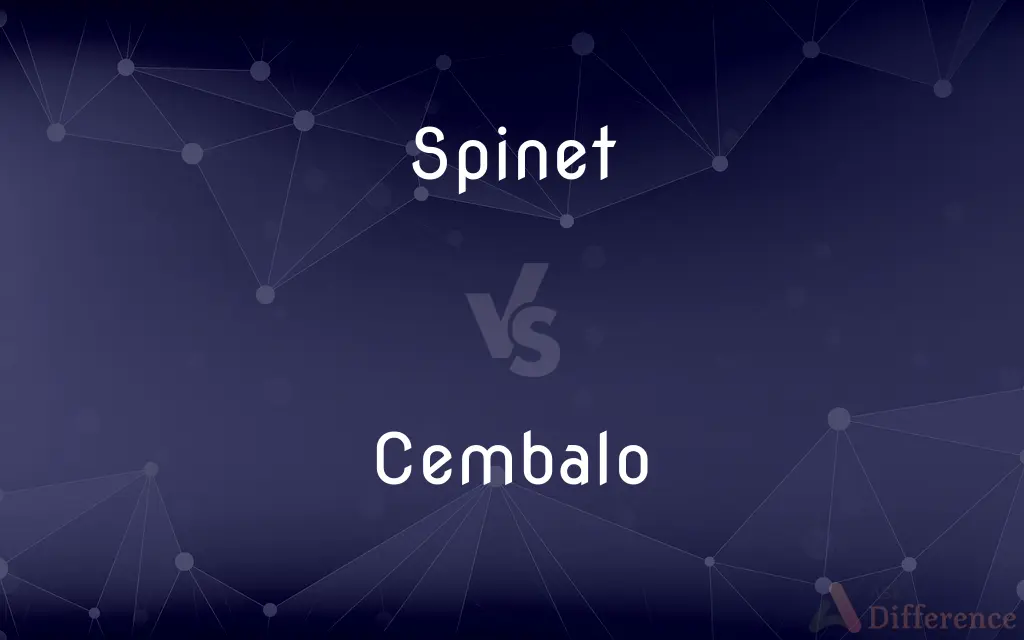Spinet vs. Cembalo — What's the Difference?
Edited by Tayyaba Rehman — By Urooj Arif — Updated on April 2, 2024
Spinet is a smaller, more compact version of the harpsichord with a unique, wing-shaped body and single keyboard, known for its delicate sound. Cembalo is larger keyboard instrument with strings plucked by quills, offering a brighter, more resonant tone.

Difference Between Spinet and Cembalo
Table of Contents
ADVERTISEMENT
Key Differences
The spinet and cembalo represent two facets of the harpsichord family, differentiated mainly by size, sound, and construction details. Spinets, by design, are compact, making them suitable for smaller spaces. They have a single set of strings and usually one keyboard, producing a softer, more intimate sound. This made spinets popular for home use during their peak in the 17th and 18th centuries. On the other hand, the term "cembalo" is often used interchangeably with harpsichord and generally refers to larger instruments that could have multiple keyboards and sets of strings, including a variety of stops to vary the sound. Cembalos are known for their louder, more brilliant tone, making them well-suited for concert settings or as part of an ensemble.
Construction-wise, the spinet's strings are typically set at an angle to the keyboard, utilizing less space, whereas cembalos have strings that run parallel or perpendicular to the keyboard, requiring more room. This arrangement in cembalos allows for a greater resonance and volume, enhancing their performance in larger venues.
The sound quality of spinets is often described as more muted and ethereal, a characteristic that lent itself well to private performances and practice. Cembalos, with their robust construction and larger soundboard, deliver a sound that's rich and full, capturing the complexity of baroque music effectively.
Despite their differences, both instruments played crucial roles in the development of keyboard music. The spinet offered an accessible option for musicians to practice or compose within their homes, while the cembalo dominated concert halls and courts with its commanding presence.
Comparison Chart
Size
Compact, suitable for small spaces
Larger, designed for concert settings
ADVERTISEMENT
Sound
Delicate, softer tone
Brighter, more resonant tone
Strings and Keys
Single set of strings, usually one keyboard
Multiple sets of strings, often multiple keyboards
Use
Ideal for home use and practice
Preferred for concerts and ensemble play
Construction
Strings set at an angle, smaller soundboard
Strings parallel/perpendicular, larger soundboard
Compare with Definitions
Spinet
Known for its angled strings and unique sound.
The spinet's unique construction contributed to its ethereal tone.
Cembalo
Dominated baroque music with its powerful presence.
Baroque compositions come to life when played on a cembalo.
Spinet
A small harpsichord with a single keyboard, producing a delicate sound.
The musician played a piece on the spinet, filling the room with soft music.
Cembalo
A keyboard instrument with strings plucked by quills, known for its bright tone.
The cembalo's resonant sound filled the concert hall.
Spinet
Compact and wing-shaped, fitting well in intimate spaces.
Her spinet stood elegantly in the corner of her small apartment.
Cembalo
Capable of a wide range of sounds through various stops.
The musician experimented with the cembalo's stops to achieve the perfect sound.
Spinet
Popular in the 17th and 18th centuries for personal use.
Composers often composed their music on a spinet due to its practical size.
Cembalo
Often has multiple keyboards and sets of strings for a richer sound.
The complex music demanded a cembalo with two keyboards.
Spinet
Offers a more intimate musical experience.
The spinet was perfect for the musician's solo practice sessions at home.
Cembalo
Larger and suited for performance settings.
The orchestra's cembalo stood prominently on stage.
Spinet
A spinet is a smaller type of harpsichord or other keyboard instrument, such as a piano or organ.
Cembalo
A harpsichord.
Spinet
A small, compact upright piano.
Cembalo
(musical instruments) A harpsichord.
Spinet
A small, compact upright electronic organ.
Cembalo
An old name for the harpsichord.
Spinet
A small harpsichord with a single keyboard.
Cembalo
A clavier with strings that are plucked by plectra mounted on pivots
Spinet
(musical instruments) A short, compact harpsichord or piano.
Spinet
(obsolete) A spinney.
Spinet
A keyed instrument of music resembling a harpsichord, but smaller, with one string of brass or steel wire to each note, sounded by means of leather or quill plectrums or jacks. It was formerly much used.
Spinet
A spinny.
Spinet
Small and compactly built upright piano
Spinet
Early model harpsichord with only one string per note
Common Curiosities
Can spinets and cembalos be used interchangeably in music?
While both can play similar music, their distinct tones and volumes make them better suited to different settings and purposes.
Are there any modern equivalents to these instruments?
Modern digital keyboards can emulate the sounds of both spinets and cembalos, offering musicians versatility in sound and volume.
What makes the cembalo suitable for concert settings?
Its larger size, multiple keyboards, and brighter, more resonant tone make it ideal for performances that require volume and richness.
What distinguishes a spinet from a cembalo?
The main differences lie in their size, sound, and construction, with spinets being smaller and softer-toned, and cembalos larger with a brighter tone.
How does the construction of a spinet affect its sound?
The angled strings and smaller soundboard of a spinet create a more muted and delicate sound compared to the cembalo.
Were spinets and cembalos used in the same musical compositions?
While they could play similar compositions, composers and musicians chose the instrument based on the desired sound and venue.
Is it difficult to maintain these historical instruments?
Yes, both spinets and cembalos require careful maintenance to preserve their unique sounds and mechanical parts.
How did the popularity of these instruments evolve over time?
Their popularity waned with the rise of the piano in the 18th century, which offered a wider dynamic range and expressive capabilities.
Why were spinets popular for home use?
Their compact size and softer sound made them ideal for smaller, private spaces.
What kind of music is best suited for a cembalo?
Baroque and early classical music, which benefits from the cembalo's rich, resonant tone, is particularly well suited for this instrument.
Share Your Discovery

Previous Comparison
Arabic vs. Arab
Next Comparison
Elf vs. GremlinAuthor Spotlight
Written by
Urooj ArifUrooj is a skilled content writer at Ask Difference, known for her exceptional ability to simplify complex topics into engaging and informative content. With a passion for research and a flair for clear, concise writing, she consistently delivers articles that resonate with our diverse audience.
Edited by
Tayyaba RehmanTayyaba Rehman is a distinguished writer, currently serving as a primary contributor to askdifference.com. As a researcher in semantics and etymology, Tayyaba's passion for the complexity of languages and their distinctions has found a perfect home on the platform. Tayyaba delves into the intricacies of language, distinguishing between commonly confused words and phrases, thereby providing clarity for readers worldwide.














































